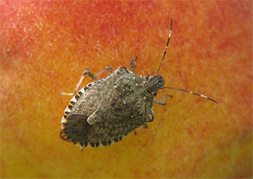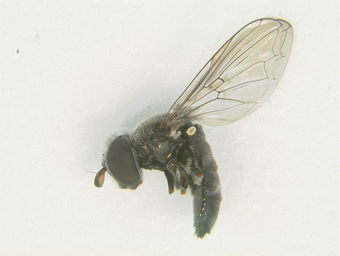Tree Fruit: Entomology Research Projects

The brown marmorated stink bug (BMSB), Halymorpha halys, is an invasive species that feeds on tree fruits and many other crops in the mid-Atlantic region and has caused causing significant economic injury to apples, pears, and most stone fruits since 2010. Given its extremely broad host range (including many native and invasive trees in forested areas), its movement between wild and cultivated hosts through much of the growing season, and a general lack of adequate suppression by native natural enemies, its on-going impact on Virginia’s tree fruit industry is a major concern. The entomology program at Virginia Tech’s Winchester AREC is responding to stakeholder needs through independent BMSB research projects and collaborative projects with researchers from USDA ARS and other land-grant universities. Annual, small-plot efficacy trials targeting BMSB are providing information on the performance of individual insecticides and seasonal programs against this pest. As well, a 3-year demonstration trial in commercial apple and peach orchards is comparing on-going refinements to prescribed programs with “grower standard” programs, with attention to efficacy against BMSB and other key pests and to program effects on secondary pests. The incidence and severity of BMSB injury to apples and peaches at discrete intervals during the fruiting period was examined using exclusion and inclusion cage studies and the distribution of BMSB injury within orchard blocks at harvest was measured at sites in several states. Pheromone-based monitoring studies seek to provide information on the season-long response of BMSB to traps, the effects of trap placement and adjacent habitat on captures, the relationship between captures and fruit injury throughout the growing season, and the latency between adult emergence from overwintering sites and captures in traps. Developmental studies using single and mixed diets of cultivated and wild hosts seek to determine host plant effects on BMSB fitness parameters and nutritional status and host-use patterns at the interface between orchards and forested areas. Seasonal patterns of the movement of BMSB nymphs within and among host plants will be investigated using passive traps deployed on the trunk of deciduous trees. Overwintering boxes within which adult BMSB settle readily will be deployed in human-made structures to address the potential for mass removal of adult bugs from these structures during the fall.
Biological Control of Woolly Apple Aphid

The woolly apple aphid (WAA), Eriosoma lanigerum (Homoptera: Eriosomatidae), is a pest of apple trees and indigenous to the eastern United States, although cosmopolitan in its distribution. While WAA populations occasionally and unpredictably reach outbreak levels in Virginia apple orchards, a guild of natural enemies usually prevents the pest from causing economic damage. This guild consists primarily of a native, specialized parasitic wasp, Aphelinus mali, and three species of predatory syrphid flies. Research at the center has shown that two of the flies are generalist aphid predators, while the third, Heringia calcarata, is a specialized predator of WAA in the apple ecosystem. H. calcarata is the most common predator early in the growing season, and research results suggest that it acts in concert with A. mali to suppress WAA outbreaks.
A. mali was exported from the U.S. to many apple producing countries in the early and mid 20th century. In some countries, it effectively and consistently controlled WAA populations, while in others its effects were less consistent. In New Zealand, WAA is currently considered the most intractable insect pest of apple, despite the widespread presence of A. mali. Scientists from Plant and Food Research New Zealand have determined that H. calcarata represents an intriguing additional biological control agent for WAA there. A collaborative project with the entomology program at the center seeks to evaluate the potential to export the fly from Virginia to New Zealand by addressing the many regulatory issues associated with introducing a non-native predator into the New Zealand ecosystem.
Managing Arthropod Pests in Virginia Apple Orchards
On-going regulatory changes are necessitating the adoption of new approaches to managing arthropod pest in Virginia tree fruits. Broad-spectrum insecticides that have long formed the cornerstone of “calendar spray,” seasonal management programs are being replaced with new, “reduced risk” products that are more physiologically and/or ecologically selective, usually limited in the number of applications allowed per season and more costly to use on a per acre basis. To optimize the efficacy and cost-effectiveness of these products and to ensure the sustainability and viability of tree fruit production, growers need continuing updates on the most effective uses of the available options for their region. Cooperative agreements between numerous agrichemical companies and the entomology program at the center involve annual evaluations of the efficacy and fit of both registered and unregistered chemistries in seasonal arthropod pest management programs conducted in research center orchards.




